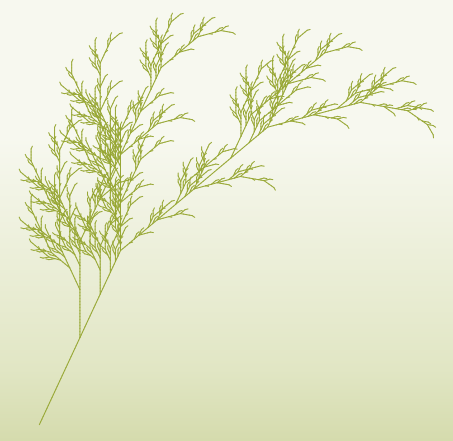Fractal plant by Sakurambo from WikiMedia
The goal of the kata is to implement a L-system interpreter which takes the system parameters (variables, start, rules and angle) and draws the result of the system given a number of iterations.
You can read about the L-systems here. You can play around with some examples over here.
The system is drawn using a "turtle" mechanism in which we have a object (the turtle), that draws the lines as it moves around the canvas. The turtle takes commands such as "go forward" or "turn X degrees left".
The commands can be written as rules and variables of the L-system, that fed to the turtle for several iteration can produce comlex structures such as fractals.
Be sure not to implement the whole thing at once, instead divide the project to parts to complete and unit test them separately. Be sure to focus on completing and testing a step before taking a new one. You can divide the project yourself or use steps provided below:
- Step 1: Write the L-system implementation, which will calculate consecutive iterarions using given rules and the starting state (the axiom).
- Step 2: Implement a "turtle" which takes commands to go forward, turn right or left.
- Step 3: Implement a mechanism which takes L-system output and makes the "turtle" follow the instructions, drawing a line as it moves on the canvas. For example: "F+F+F-F++", where "F" means forward, "+" means turning right and "-" means turning left.
- Step 4: Use the L-system to draw a fractal such as Lévy C curve, Koch curve, Sierpiński triangle or a Dragon curve
- Step 5: Use your imagination! Add a mode which draws the figures slowly, so the process is visible. Add colors or more accent. Do something with the lines that were drawn several times. You can also tackle a more complicated L-system like Fractal plant, which requires additional changes to the turtle (and produces a very cool fractal).
index.htmlMain and only html file, hosting the canvas, also contains css styles.app.jsMain JS file, contains the library used for drawing, which is p5.js.turtle.jsIs a simplistic turtle implementation, which can only go forward.l-system.jsYour L-system, may be a good place to start.
The program uses p5.js for drawing on a canvas. It's a JS implementation
of a popular creative coding tool Processing. In the app.js file there are two methods:
setup, which runs only once at the start of the script,draw, which runs every frame of the animation
P5 has a long range of useful methods that can be used for drawing, all of which are listed in the reference. Here are methods that you'll find most useful:
Be sure to explore more creative options if you'll have some time left :)
- Use TDD, try and write a SOLID code.
- Be careful about iterating too many times using the L-system, too many iterations will produce strings that can kill your browser.
- Take your time to test and refactor. The Dojo is about completing the task using best practices and not about how much you'll be able to complete.
- When searching for L-system grammars on Wikipedia notice that the minus character on the wiki is different that the standard one, which can cause problems when interpretting commands.
- Make sure that most of your code is not dependent strictly on p5, think what could happen if you were to switch the drawing library.
- If you are not seeing the turtle drawing lines, be sure that it's not outside the canvas (the x,y are not negative).
- Install Node.js
- To install dependencies:
npm i - Run development server::
npm run dev - Run tests:
npm run test
